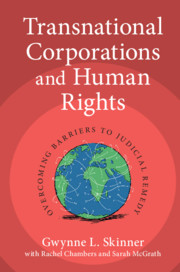Book contents
- Transnational Corporations and Human Rights
- Transnational Corporations and Human Rights
- Copyright page
- Dedication
- Dedication
- Contents
- Foreword
- Abbreviations
- Table of Cases
- Table of Statutes
- Introduction
- Part I Rise of Transnational Corporations, Impact on Human Rights, And Victims’ Rights to Remedy
- 1 Growth and Structure of TNCs
- 2 Victims’ Rights To Remedy for Business-Related Human Rights Violations
- 3 Barriers to Judicial Remedies in Host Countries
- 4 Limits on Subject Matter Jurisdiction over International Human Rights Violations
- 5 Limited Liability of Parent Corporations
- 6 Lack of In Personam Jurisdiction over TNCs and their Affiliates
- Part II Legal Barriers to Remedy and How to Overcome Them
- Conclusion
- Select Bibliography
- Index
2 - Victims’ Rights To Remedy for Business-Related Human Rights Violations
from Part I - Rise of Transnational Corporations, Impact on Human Rights, And Victims’ Rights to Remedy
Published online by Cambridge University Press: 04 September 2020
- Transnational Corporations and Human Rights
- Transnational Corporations and Human Rights
- Copyright page
- Dedication
- Dedication
- Contents
- Foreword
- Abbreviations
- Table of Cases
- Table of Statutes
- Introduction
- Part I Rise of Transnational Corporations, Impact on Human Rights, And Victims’ Rights to Remedy
- 1 Growth and Structure of TNCs
- 2 Victims’ Rights To Remedy for Business-Related Human Rights Violations
- 3 Barriers to Judicial Remedies in Host Countries
- 4 Limits on Subject Matter Jurisdiction over International Human Rights Violations
- 5 Limited Liability of Parent Corporations
- 6 Lack of In Personam Jurisdiction over TNCs and their Affiliates
- Part II Legal Barriers to Remedy and How to Overcome Them
- Conclusion
- Select Bibliography
- Index
Summary
While TNCs stand to benefit greatly from their work in less developed or developing countries, it is frequently the local, most vulnerable populations and communities – often nonconsenting to the development – who absorb most of the costs associated with this economic activity in the form of lower labor and regulatory costs, environmental damages, and civil and human rights violations.1 Although many TNCs are responding to human rights violations by acting responsibly, engaging in due diligence,2 and otherwise establishing mechanisms to assist in the prevention of human rights violations, when violations do occur, victims often do not have any remedy available to them.
- Type
- Chapter
- Information
- Transnational Corporations and Human RightsOvercoming Barriers to Judicial Remedy, pp. 14 - 27Publisher: Cambridge University PressPrint publication year: 2020

